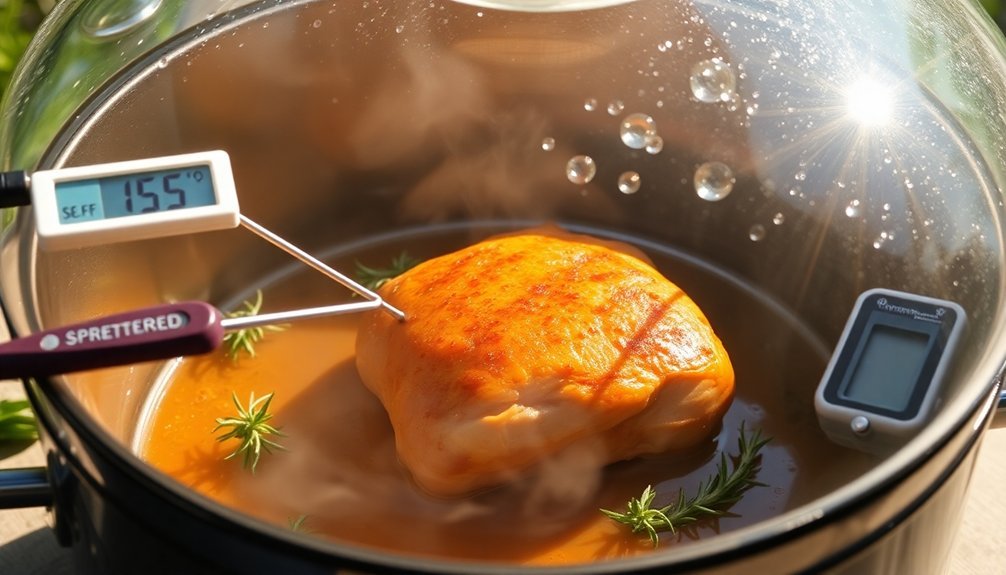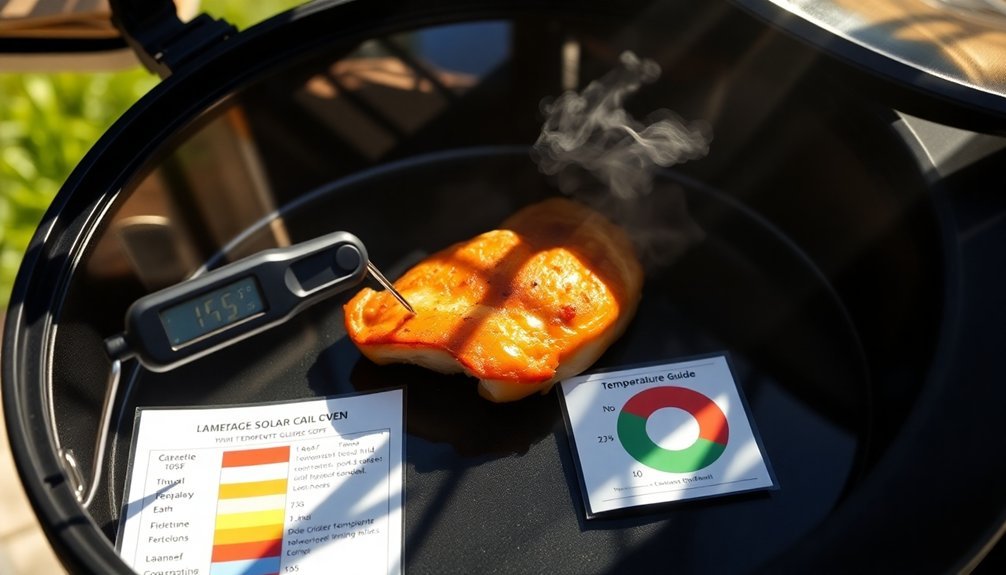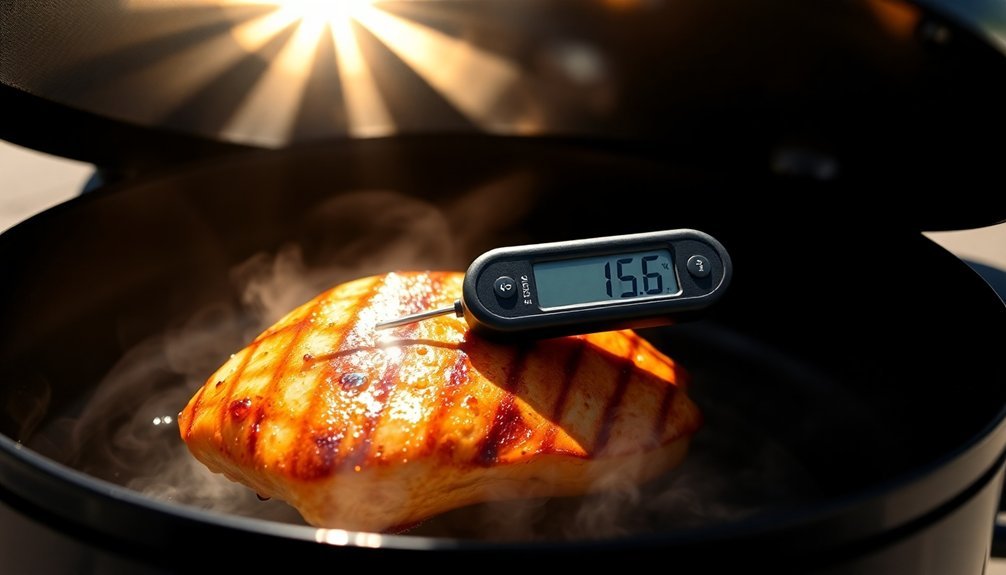When solar cooking meat, you'll need to follow three critical temperature checkpoints for safety. First, guarantee your solar oven maintains a cooking temperature between 180°F and 250°F using a digital probe thermometer. Second, verify that meats reach their required minimum internal temperatures: 145°F for whole cuts, 160°F for ground meats, and 165°F for all poultry. Third, keep foods out of the danger zone (40°F-140°F) where bacteria thrive, limiting exposure to no more than 2-4 hours. Master these temperature guidelines, and you'll reveal the secrets to safe, successful solar cooking.
Safe Internal Temperature Zones

When cooking meat using solar power, reaching and maintaining safe internal temperatures is essential for food safety.
You'll need to verify your whole cuts of meat reach at least 145°F, while ground meats must hit 160°F. For all poultry, including ground chicken and turkey, cook until you've reached 165°F.
Your solar cooker needs to get meat out of the danger zone (40°F-140°F) quickly, as bacteria multiply rapidly in this range. Using a digital probe thermometer inserted into the thickest part of the meat will give you the most accurate temperature reading.
Don't let your meat stay in this zone for more than 2-4 hours. If you're reheating leftovers, bring them to 165°F for safety.
Remember that different cuts have different requirements – fresh ham needs 160°F, while all poultry parts, from breasts to wings, must reach 165°F.
Always use a reliable meat thermometer to verify these temperatures.
Monitoring Your Solar Oven
Proper monitoring of your solar oven's temperature can make the difference between a perfect meal and an undercooked disaster. You'll need reliable digital probe thermometers that can measure between -50°C to 300°C, ensuring your food reaches safe cooking temperatures of 180°F to 250°F. Buffered probe sensors provide the most reliable readings compared to measuring air temperature alone.
| Time of Day | Best Practice | Key Action |
|---|---|---|
| Morning | Position Setup | Face oven to morning sun |
| Midday | Peak Cooking | Check temps every 30 min |
| Afternoon | Adjustment | Rotate oven with sun path |
Keep track of your oven's performance using mobile apps connected to temperature sensors. Set alerts for when temperatures drop below cooking range, and you'll want to reposition your oven every 1-2 hours between 11 AM and 3 PM to maintain ideal heat. Use dark cookware with tight lids to retain heat, especially when clouds pass overhead.
Danger Zone Prevention Strategies

Maintaining safe food temperatures goes beyond just monitoring your solar oven's readings.
You'll need to keep your food out of the danger zone (40°F-140°F) where bacteria multiply rapidly. Start by preheating your solar oven to at least 140°F before adding any meat, and aim for 200°F when possible.
Don't let your food sit in the danger zone for more than 2 hours. If you're cooking meat, verify it reaches proper internal temperatures: 145°F for whole cuts, 160°F for ground meats, and 165°F for poultry. Using a Type-K thermocouple provides the most accurate temperature readings for food safety.
Stir liquids and rotate solid foods every 10-15 minutes for even heating. If your solar oven can't maintain safe temperatures due to weather conditions, switch to an alternative heat source to complete the cooking process.
Frequently Asked Questions
Can Marinades Affect Temperature Reading Accuracy in Solar-Cooked Meats?
Yes, marinades can affect your temperature readings' accuracy in solar-cooked meats. You'll find that ingredients like water, oils, and sugars change heat conductivity and create insulating crusts that may skew your measurements.
How Do Different Meat Thicknesses Impact Cooking Times in Solar Ovens?
You'll find thicker cuts take longer to cook in your solar oven. Large roasts need 5-8 hours, medium pieces like chicken breasts take 3-5 hours, while thinly sliced meats cook in just 1-3 hours.
Should Meat Be Covered or Uncovered When Solar Cooking?
You'll want to cover your meat most of the time during solar cooking to retain heat and moisture. Only uncover briefly to check doneness or when you need browning for texture and appearance.
Does Altitude Affect Required Cooking Temperatures for Meat in Solar Ovens?
No, you'll need to reach the same safe internal meat temperatures regardless of altitude. While altitude affects water's boiling point and cooking time, it doesn't change the temperature required for safely cooking meat.
Can Pre-Searing Meat Reduce Solar Cooking Time to Reach Safe Temperatures?
No, pre-searing your meat won't considerably reduce solar cooking time to reach safe temperatures. While it'll enhance flavor and kill surface bacteria, the time needed to reach proper internal temperatures remains largely unchanged.
In Summary
You'll need to consistently monitor temperatures when solar cooking meats to guarantee food safety. Remember your target zones: 145°F for whole cuts, 160°F for ground meats, and 165°F for poultry. Keep your solar oven's temp gauge visible and check regularly. Don't let food linger in the danger zone between 40-140°F. If you're unsure about the temperature, it's better to continue cooking.





Leave a Reply